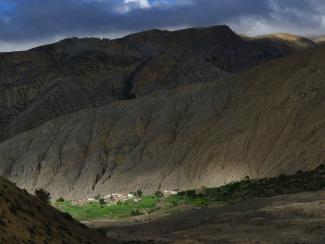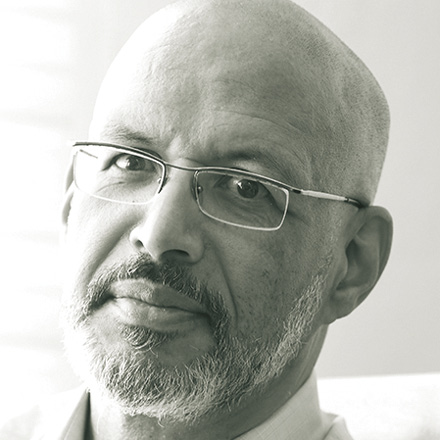Water
Fleeing drought
 Daniel Pittet
Daniel Pittet
Mustang is a tough place to live because of desert-like drought, freezing cold, strong daytime winds and high altitudes. In the south, Mustang is bordered by the two enormous mountains, Dhaulagiri and Annapurna, which act as a massive moisture barrier, separating one of the wettest from one of the driest regions of Nepal. The northern part of the district, which is called Lo, is linguistically and culturally closely tied to Tibet. By road, it can only be reached from the People’s Republic of China. In Lo, streams in the valleys are vital for the survival of the local people. They supply the water to cultivate staple foods like buckwheat and barley. Without irrigation, agriculture would be impossible in this arid region where rainfall averages barely 200 millimetres per year.
In the past half-century, however, the water flowing in some of Lo’s streams has dwindled. Villagers report that many people have been forced to abandon some of their cropland, as one can see by underused land in many places. And the problem threatens to worsen.
According to climate expert Mario Rohrer, the amount of precipitation will not change significantly in the coming years, but he expects a temperature increase of four to ten degrees Celsius by the end of the century. Accordingly, there will be less precipitation in form of snow too, and snow covers will be prone to melting faster. This matters, because streams that are fed by melting snow flow more continuously than do rain-fed streams with comparatively volatile water volumes. Many streams in Lo are not fed by glaciers which have the most dependable water resources. Rohrer’s assessment is based on calculations done by the Intergovernmental Panel on Climate Change.
The lack of water is already so serious that villagers wonder whether they should relocate. They cannot rely on state support, as government institutions hardly have a bearing on their remote valley. Social cohesion in the villages is very strong and decisions are made collectively.
Experts view
In order to analyse the situation, experts from the Swiss NGO Kam For Sud and the University of Applied Sciences and Arts of Southern Switzerland (SUPSI) travelled to Lo. Our team wanted to evaluate whether a relocation of the villages Samzong, Yara and Dheye would be necessary and beneficial. Locally, we were supported by the Mustang Foundation (LMF), which is run by Ngawang Kunga Bista, a Buddhist Lama.
All three villages have similar hydrological conditions. In each case, the water supply is dwindling. Residents will eventually be pushed to the brink of their existence. All three villages are located near streams which are not fed by glaciers and therefore may easily dry up periodically in the future. We interviewed each of the 53 families who live in the villages. They say they need all of the stream water to irrigate their grain fields. If the water level drops, this will have a direct impact on their farms and their food security.
It would be possible to bridge the problem in the short term, for example by using plastic pipes instead of irrigation channels, as that would reduce water losses. Such measures, however, would only delay the problem by a few years. The only long-term solution is to cut water usage, and that would imply reducing agricultural operations too.
According to our study, this approach would be viable only in Yara. Yara is relatively well developed and offers tourist and religious attractions, so its people can find alternative livelihoods. A long-term adaptation strategy of focussing on non-agricultural activities and making the irrigation system more efficient could succeed in this village. In view of recent trends, Yara’s relocation looks avoidable.
Relocation inevitable
Samzong and Dheye, however, have no such options, so we recommend that the residents move to new places. The villagers have already chosen lower situated places where the water resources will not be depleted so quickly. The streams in those places are fed by glaciers, the giant water reserves of which will last at least until the end of the century.
Relocation must be thoroughly planned, however, and the risks must be carefully assessed. We made suggestions about how the new villages should be built. We recommend a modular village layout. Every family should get a plot of land of the same size and shape for cultivating as it pleases. It is important to have enough space to expand individual plots as well as the villages as a whole. Moreover, the plots must be arranged well, since they will be more exposed to wind than the villagers are accustomed to. The plots should be laid out in a semi-circle and surrounded by a wall of five meters height to protect them from wind.
A serious challenge is that the suggested location for the Samzong fields is at risk of flash flooding due to Glacier Lake Outburst Floods (GLOFs). GLOFs occur when lakes of accumulating water within glaciers are suddenly drained. Global warming will make GLOFs occur more often in the future. We therefore developed a geological hazard map and made recommendations about how to protect the fields by erecting a dam.
The new location for Dheye is an area of approximately 25 acres on a slightly raised plateau. The main difficulty is that it is not clear what is the easiest way to get water on to this elevated plane.
No doubt, Samzong, Yara and Dheye must act soon. Their survival is in danger. Lama Ngawang Kunga Bista says: “You Westerners caused the problems, now you have to help us solve them.” Accordingly, Kam For Sud is planning another project with its Nepalese partner LMF. Both sides hope to find answers to the remaining technical questions – for example, how to transport water to Dheye’s new location.
Daniel Bernet works as a technical consultant for Kam For Sud, a Swiss NGO active in Nepal. He is a co-author of the study mentioned in the article.
bernet.d@gmail.com
http://www.kamforsud.org

